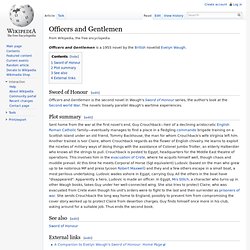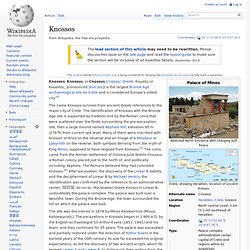

Officers and Gentlemen. Officers and Gentlemen is a 1955 novel by the British novelist Evelyn Waugh.

Sword of Honour[edit] Officers and Gentlemen is the second novel in Waugh's Sword of Honour series, the author's look at the Second world War. The novels loosely parallel Waugh's wartime experiences. Plot summary[edit] Sent home from the war at the first novel's end, Guy Crouchback—heir of a declining aristocratic English Roman Catholic family—eventually manages to find a place in a fledgling commando brigade training on a Scottish island under an old friend, Tommy Backhouse, the man for whom Crouchback's wife Virginia left him. See also[edit] Sword of Honour External links[edit] A Companion to Evelyn Waugh's Sword of Honour: Home Page. Daedalus. Family[edit] The Labyrinth[edit] Daedalus is first mentioned by Homer as the creator of a wide dancing-ground for Ariadne.[12] He also created the Labyrinth on Crete, in which the Minotaur (part man, part bull) was kept.

In the story of the labyrinth as told by the Hellenes, the Athenian hero Theseus is challenged to kill the Minotaur, finding his way with the help of Ariadne's thread. Daedalus' appearance in Homer is in an extended metaphor, "plainly not Homer's invention", Robin Lane Fox observes: "he is a point of comparison and so he belongs in stories which Homer's audience already recognized".[13] In Bronze Age Crete, an inscription da-da-re-jo-de has been read as referring to a place at Knossos,[14] and a place of worship.[15] In Homer's language, objects which are daidala are finely crafted. This story thus encourages others to consider the long-term consequences of their own inventions with great care, lest those inventions do more harm than good.
Daedalus and Icarus[edit] Knossos. Knossos, Knossus, or Cnossus (/ˈnɒsəs/; Greek: Κνωσός or Κνωσσός, pronounced [knoˈsos]) is the largest Bronze Age archaeological site on Crete and is considered Europe's oldest city.[4] The name Knossos survives from ancient Greek references to the major city of Crete.

The identification of Knossos with the Bronze Age site is supported by tradition and by the Roman coins that were scattered over the fields surrounding the pre-excavation site, then a large mound named Kephala Hill, elevation 85 m (279 ft) from current sea level. Many of them were inscribed with Knosion or Knos on the obverse and an image of a Minotaur or Labyrinth on the reverse, both symbols deriving from the myth of King Minos, supposed to have reigned from Knossos.[5] The coins came from the Roman settlement of Colonia Julia Nobilis Cnossus, a Roman colony placed just to the north of, and politically including, Kephala. The site was discovered in 1878 by Minos Kalokairinos (Μίνως Καλοκαιρινός). File:Gehörnter Gott, Enkomi.jpg. Minotaur. In Greek mythology, the Minotaur (/ˈmaɪnətɔː/,[1] /ˈmɪnəˌtɔr/;[2] Ancient Greek: Μῑνώταυρος [miːnɔ̌ːtau̯ros], Latin: Minotaurus, Etruscan Θevrumineś), was a creature with the head of a bull on the body of a man[3] or, as described by Roman poet Ovid, "part man and part bull".[4] He dwelt at the center of the Cretan Labyrinth, which was an elaborate maze-like construction[5] designed by the architect Daedalus and his son Icarus, on the command of King Minos of Crete.

The Minotaur was eventually killed by the Athenian hero Theseus. "Minotaur" was originally a proper noun in reference to this mythical figure. The use of "minotaur" as a common noun to refer to members of a generic race of bull-headed creatures developed much later, in 20th-century fantasy genre fiction. Birth and appearance[edit] The bronze "Horned God" from Enkomi, Cyprus After he ascended the throne of Crete, Minos competed with his brothers to rule.
Theseus and the Minotaur[edit] Etruscan view[edit] Interpretations[edit]